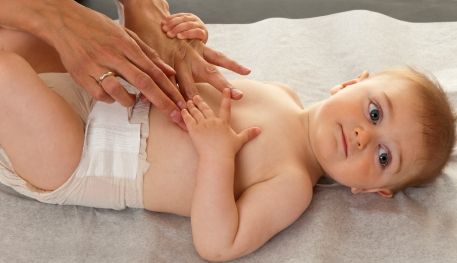This article explains how the technique of laparoscopic surgery can be applied to infants and children and what procedures can routinely be performed in this way.
Contents
- Introduction
- Keyhole surgery for inguinal hernias in children
- Keyhole surgery for un-descended testicles in children
- Keyhole surgery for acute appendicitis in children
- Keyhole surgery for gall bladder stones in children
- Keyhole surgery for gastro-oesophageal reflux in children
- Neonatal (new-born) keyhole surgery
- Conclusion
Introduction
Keyhole (laparoscopic) surgery involves making small openings on the abdominal wall, usually no more than a few millimetres big. Through these openings special devices called ports are inserted that allow cameras and long instruments to be inserted into the abdominal cavity to enable the surgeon to perform the operation. A gas (Carbon Dioxide) is used to temporarily swell the abdominal cavity so that the surgeon can see the organs inside the tummy and perform the surgery. At the end of the procedure the gas is removed. The size of the space in which to perform this surgery in infants and children is small and the surgeon must possess a high level of skill and expertise to undertake this surgery safely.
A number of common conditions can be treated by using keyhole (laparoscopic) surgery. Other, more major, operations can also be performed this way and I will discuss these below.
Keyhole surgery for inguinal hernias in children
Hernias in infants and children produce an intermittent swelling that appears in the groin (inguinal hernia). It’s more common in boys but can occur in girls as well. The swelling is produced by the intestine (in boys) and the ovary (in girls) pushing out of the abdominal cavity through an opening in the muscles in the groin. This opening should have closed off naturally before or soon after birth. It can be a dangerous problem for the child, trapping and damaging the intestine or stopping blood flow to the testicle in boys and the ovary in girls. In infants keyhole surgery can be performed to close the opening from the inside, which is performed without having to touch the delicate structures going to the testicle and ovary. In approximately one in ten children an opening may exist on the opposite side and keyhole surgery allows this to be seen and repaired before it develops into a second hernia. Three small openings are required, one in the belly button and on the left and right side. The side openings are so small that they can be closed with special biological glue only. For the majority of children this procedure can be performed as a day-case patient.
Keyhole surgery for un-descended testicles in children
This is a common condition in boys. In 80% of children the testicle can be felt in an abnormal position and brought down to the scrotum with a simple superficial operation and keyhole surgery is not required. In the remaining 20% the testicle is mostly trapped high in the groin or abdominal cavity or rarely is missing. When the testicle cannot be felt keyhole surgery provides the most reliable way of finding out where it is and bringing it down to a normal position in the scrotum. This often requires two operations both of which can be performed by keyhole surgery.
Keyhole surgery for acute appendicitis in children

This is the most common condition requiring emergency surgery in children. Keyhole surgery now provides a way to safely remove the inflamed appendix without the need for large and painful scars. In some children the cause of abdominal pain may not be clear and in these circumstances keyhole surgery allows visual inspection of the organs to assist with the diagnosis.
Keyhole surgery for gall bladder stones in children
Removing a gall bladder that is inflamed or contains stones is now a well-established keyhole surgery operation in adults. It is required far less often in children and only in the face of a background abnormality such as a blood disorder or the need for long term intra-venous feeding. It is easily performed in children provided the surgeon is skilled in keyhole surgery.
Keyhole surgery for spleen removal in children
Children who have disorders where the spleen traps components of the blood stream can benefit from having the spleen removed. This is an ideal operation to be performed with keyhole surgery as the scar from the open operation is both large and painful during recovery. It is an operation that should only be undertaken by an expert in children’s keyhole surgery.
Keyhole surgery for gastro-oesophageal reflux in children
Reflux of stomach contents back into the throat can be a distressing and sometimes dangerous problem for children. Fortunately, the majority of children are successfully treated with medication and symptoms often settle as the child matures. In a small proportion of children, particularly if the child has cerebral palsy of other neurological problems, surgery may be needed to stop the reflux from occurring if medication is not successful. The most common procedure is called a Nissen Fundoplication. In this operation the top of the stomach (fundus) is wrapped around the lower part of the gullet (oesophagus) to ensure that the stomach contents can’t reflux back up the gullet into the throat. This is an ideal operation to be performed with keyhole surgery as this leads to minimal internal scarring, quicker, less painful recovery and reduced hospital stay.
Neonatal (new-born) keyhole surgery
Keyhole surgery can now be used to treat life threatening congenital abnormalities. These are structural abnormalities that are sometimes seen before birth or diagnosed soon after. Such conditions include:
- Bowel atresia (a condition where the bowel has not formed as a continuous tube and so is blocked. This can affect the oesophagus, stomach or the small and large intestine).
- Diaphragmatic hernia (a condition where the diaphragm muscle that separates the chest from the tummy has not formed allowing the bowel to squeeze into the chest and squash the developing heart and lungs).
Conclusion
Laparoscopic or keyhole surgery is a major revolution in new-born and children’s surgery. It requires patience, skill and extensive training. The benefits of reduced pain and scarring mean that paediatric surgeons should look to perform surgery laparoscopically wherever possible. Parents should enquire about these techniques when discussing surgery for their child.
Associated with the nervous system and the brain.
Full medical glossary
